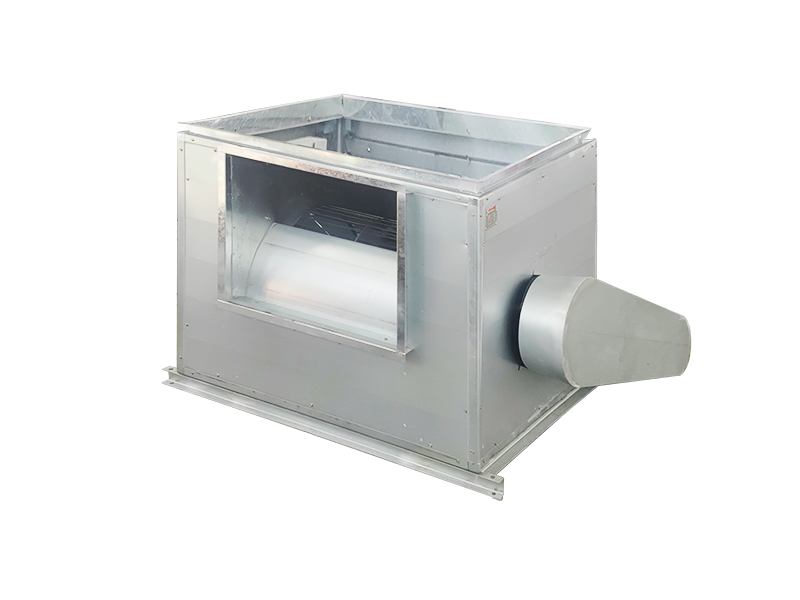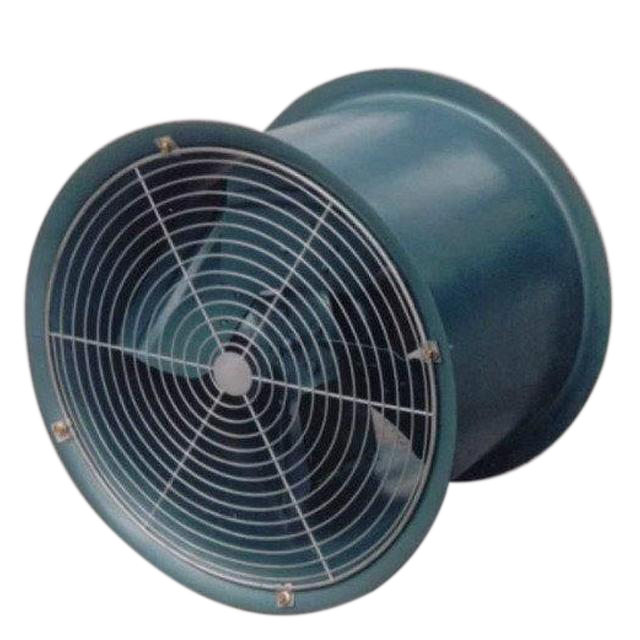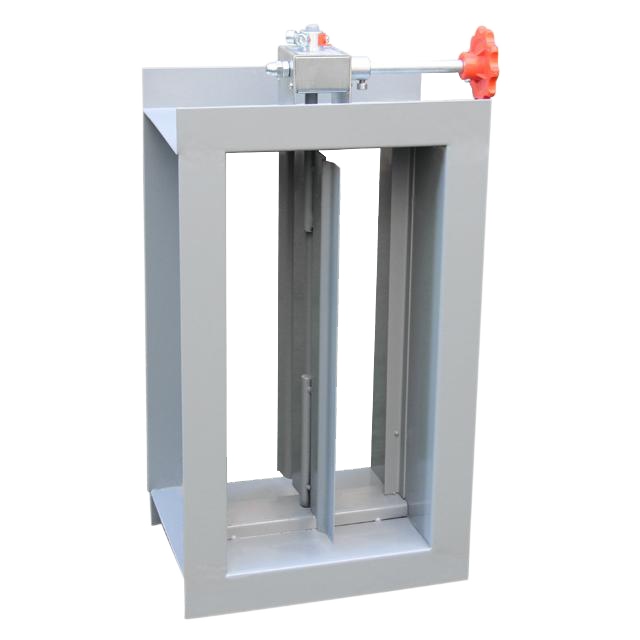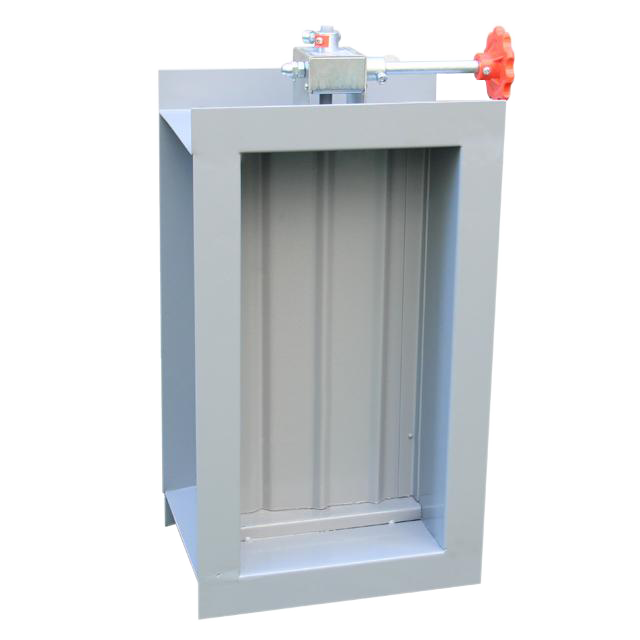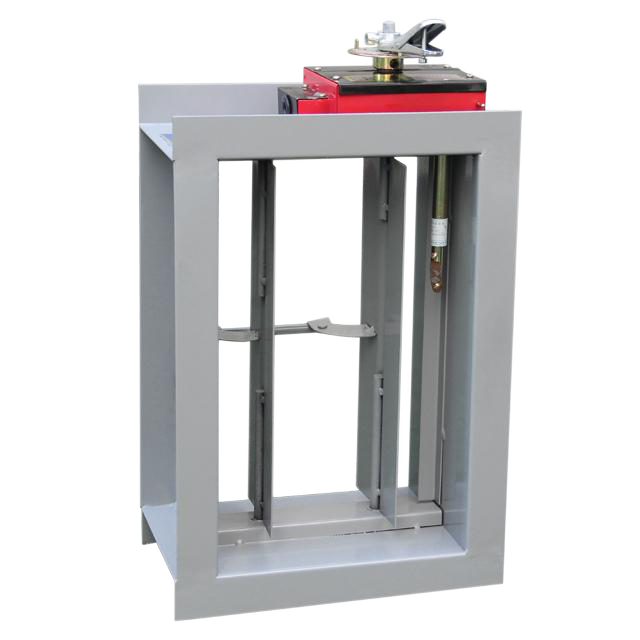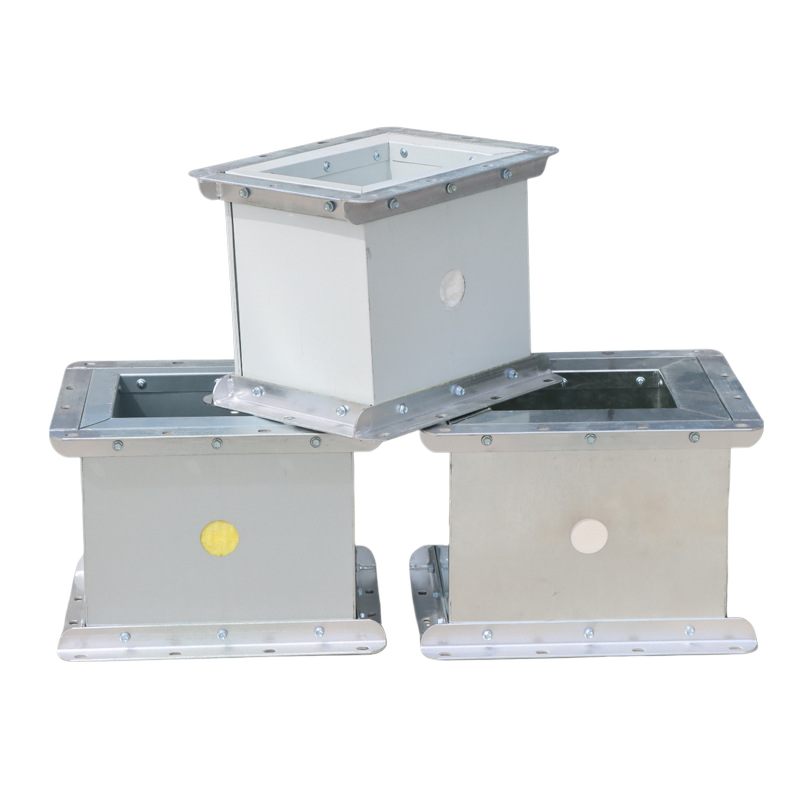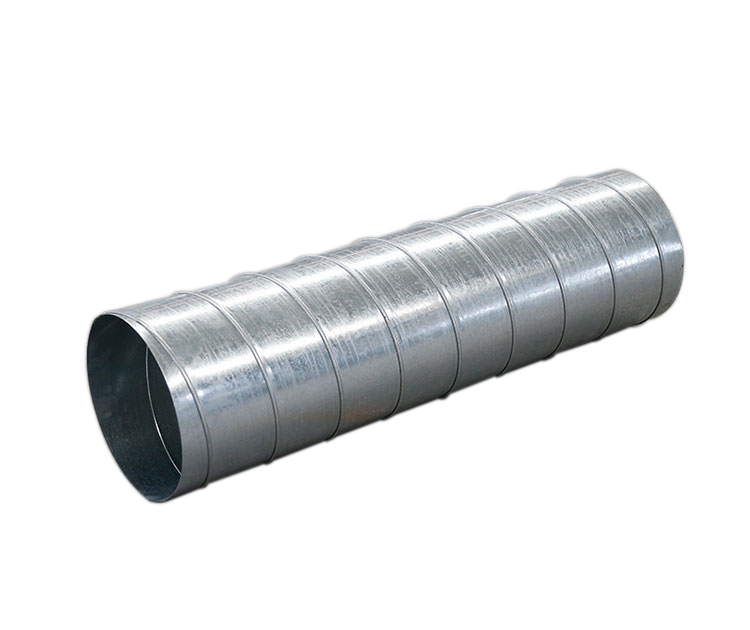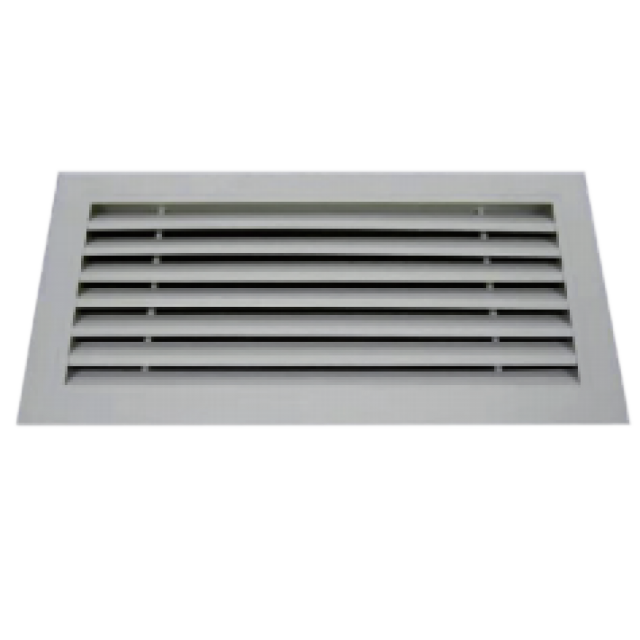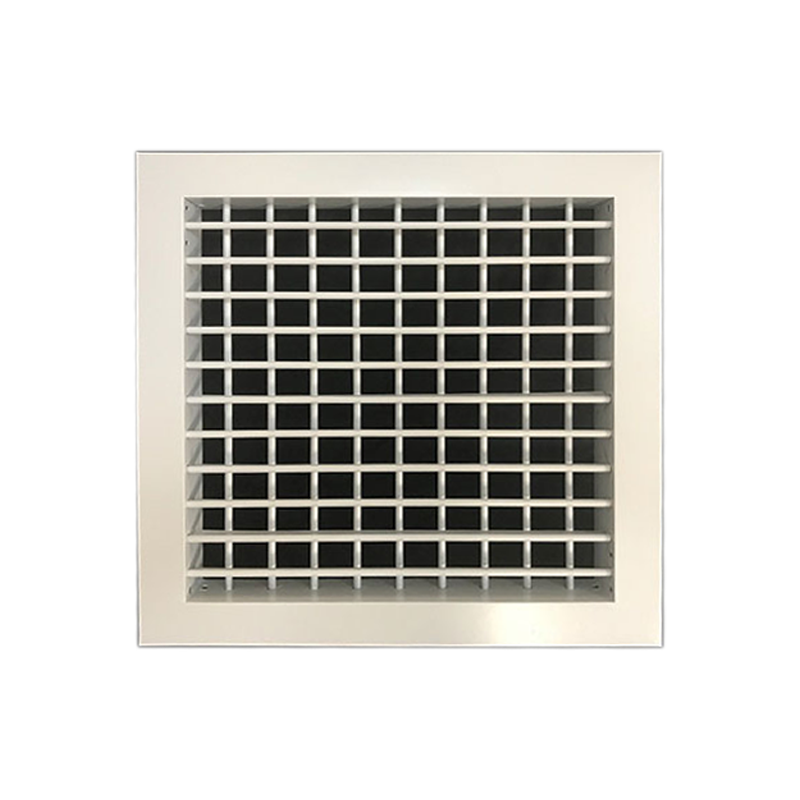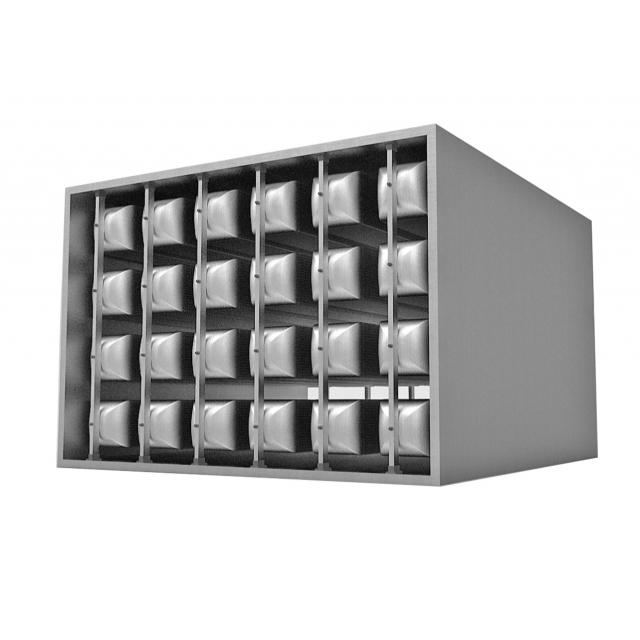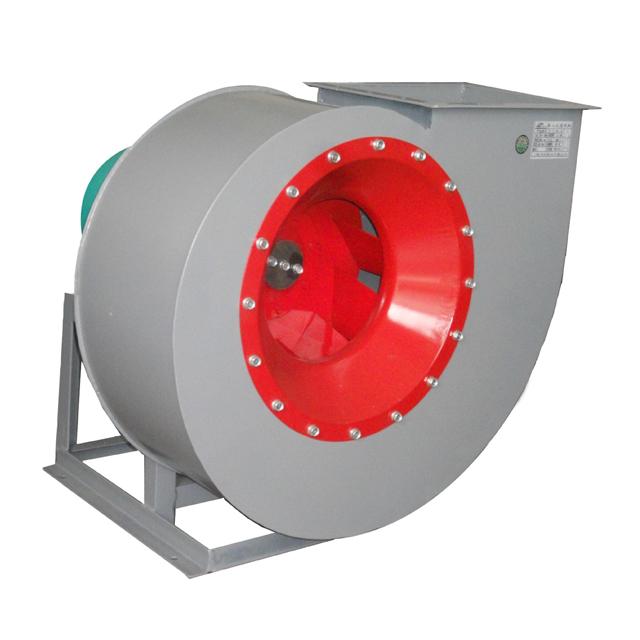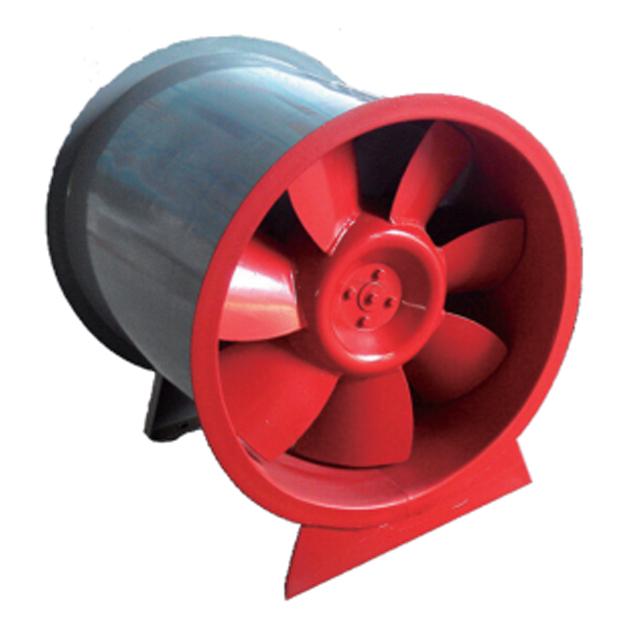How does it work?
What are the ventilation equipment available?
Centrifugal smoke exhaust fan
Figure 1 Cabinet centrifugal smoke exhaust fan
Figure 2 Centrifugal ventilation fan
Definition
The definition and classification of centrifugal ventilation fans, as a widely used ventilation equipment in industries, buildings, and agriculture, are crucial for a deeper understanding of their working principles and application scenarios. A centrifugal ventilation fan, as the name suggests, is a device that sucks in air from the inlet through centrifugal force, accelerates through a rotating impeller, and then exhausts it from the outlet. According to their different structures and working principles, centrifugal ventilation fans can be divided into various types, such as single-stage centrifugal fans, multi-stage centrifugal fans, and axial flow centrifugal fans.
The single-stage centrifugal fan has a simple structure and is suitable for situations with low air volume and low pressure requirements, such as household ventilation and small workshops. Multi stage centrifugal fans achieve higher wind pressure and airflow through the series connection of multiple impellers, and are widely used in large industrial plants, high-rise buildings, and other places that require a lot of ventilation. Axial flow centrifugal fans combine the characteristics of axial flow fans and centrifugal fans, and have advantages such as large air volume, low noise, and stable operation. They are commonly used in large air conditioning and ventilation systems.
In practical applications, the classification of centrifugal ventilation fans not only helps us choose suitable equipment, but also helps us better understand their working principles and performance characteristics. For example, in large industrial plants, due to the need to handle a large amount of exhaust gas and heat, multi-stage centrifugal fans are usually chosen to meet the needs of high wind pressure and large air volume. In high-rise buildings, due to limited space and high noise requirements, axial centrifugal fans become a more suitable choice.
operational principle
The working principle of a centrifugal ventilation fan is based on the action of centrifugal force. The rotating impeller sucks in and accelerates the air, and then throws out the high-speed airflow along the tangent direction, forming a certain wind pressure and flow rate. This feature makes centrifugal ventilation fans widely used in multiple fields. For example, in the industrial field, centrifugal ventilation fans are often used for ventilation, cooling, and other scenarios. Their efficient air output and stable performance enable the smooth progress of industrial production processes. In the field of construction, centrifugal ventilation fans are often used in air conditioning systems, smoke exhaust systems, etc., providing a comfortable environment and safety guarantee for the interior of buildings.
One of the characteristics of centrifugal ventilation fans is large air volume and high air pressure. This is due to its unique impeller design and efficient motor drive. Through precise calculation and optimized design, centrifugal ventilation fans can achieve high air pressure output while ensuring air volume, meeting the needs of various complex scenarios. In addition, centrifugal ventilation fans also have the characteristics of low noise and stable operation. In practical applications, these characteristics make centrifugal ventilation fans the preferred equipment in many fields.
Taking a large industrial plant as an example, centrifugal ventilation fans are used for ventilation and air exchange. By reasonably arranging the number and position of fans, as well as accurately adjusting fan parameters, effective air circulation and temperature control inside the factory building have been achieved. This not only improves the work comfort of employees, but also reduces the failure rate of equipment and improves production efficiency. This case fully demonstrates the advantages and effects of centrifugal ventilation fans in practical applications.
In addition, centrifugal ventilation fans also have high energy efficiency and environmental performance. By adopting advanced energy-saving technologies and environmentally friendly materials, centrifugal ventilation fans not only reduce energy consumption but also reduce environmental pollution. This is in line with the current concept of green development and an important direction for the future development of centrifugal ventilation fans.
In summary, centrifugal ventilation fans play an important role in multiple fields due to their unique working principles and significant characteristics. With the continuous progress of technology and the expansion of application scenarios, centrifugal ventilation fans will continue to play a greater role, bringing more convenience and benefits to people's production and life.
application area
In the industrial field, centrifugal ventilation fans play a crucial role. Taking the steel smelting industry as an example, centrifugal ventilation fans are widely used in the ventilation and cooling systems of key equipment such as blast furnaces and converters. Through efficient air volume regulation and temperature control, centrifugal ventilation fans ensure the stability and safety of the smelting process, and improve production efficiency. According to statistics, the application of centrifugal ventilation fans in large steel enterprises has increased the operating efficiency of smelting equipment by nearly 20%, significantly reducing energy consumption and production costs.
In the field of construction, centrifugal ventilation fans play an indispensable role. With the continuous progress of modern building technology, ventilation systems have become a key element in ensuring the comfort and safety of the internal environment of buildings. Centrifugal ventilation fans play an important role in building ventilation systems due to their efficient and stable performance characteristics.
In the field of agriculture, centrifugal ventilation fans play an indispensable role. Taking greenhouse planting as an example, centrifugal ventilation fans provide a suitable growth environment for crops through effective air circulation. In large greenhouses, fans can ensure air circulation, reduce the occurrence of diseases and pests, and improve crop yield and quality. According to research data, greenhouses using centrifugal ventilation fans can increase crop growth rate by more than 20%, while significantly reducing the incidence of diseases and pests. In addition, centrifugal ventilation fans also play an important role in the field of agricultural drying. For example, in the process of grain drying, the fan can quickly remove moisture, improve drying efficiency, and reduce mold and loss of grain. According to relevant statistics, the efficiency of using centrifugal ventilation fans for grain drying has increased by more than 30% compared to traditional methods, effectively ensuring the quality and storage safety of grain.
Axial flow ventilation fan
Figure 3 Axial flow ventilation fan
Definition
Axial flow fan, as an important ventilation equipment, mainly refers to the ventilation fan where the airflow flows along the axis direction. Axial fans can be classified into various types based on their structure, purpose, and performance. Among them, according to structure, it can be divided into single-stage and multi-stage axial flow fans. The single-stage axial flow fan has a simple structure and is suitable for general ventilation needs; Multi stage axial flow fans, on the other hand, have higher air pressure and flow rate, making them suitable for large industrial sites. According to their usage, they can be divided into industrial axial fans and civilian axial fans. Industrial axial fans usually have higher durability and stability, and can cope with harsh working environments; Civil axial fans, on the other hand, place greater emphasis on comfort and energy efficiency, and are widely used in the fields of construction and home furnishings.
In terms of classification, axial fans can also be classified based on their performance characteristics, such as high-efficiency and low-noise axial fans, explosion-proof axial fans, etc. The efficient and low-noise axial flow fan achieves a perfect combination of efficient ventilation and low-noise operation through optimized design and advanced noise reduction technology, and is widely used in noise sensitive places; The explosion-proof axial flow fan has a special explosion-proof design, which can operate safely in flammable and explosive environments, providing strong protection for industrial safety.
operational principle
The core of the working principle of an axial fan lies in its internal rotating blades, which rotate at high speed under the drive of an electric motor, forming a continuous airflow. Its characteristic is that the airflow direction is basically parallel to the axis of the fan, making axial flow fans have significant advantages in ventilation, heat dissipation, and exhaust applications. For example, in large data centers, axial fans ensure the stable operation of servers and other equipment through their efficient airflow organization, reducing the failure rate caused by overheating. According to statistics, data centers using axial fans can improve heat dissipation efficiency by more than 30% compared to traditional ventilation methods.
Another notable feature of axial fans is their low noise design. By optimizing the blade shape and adopting advanced noise reduction technology, the axial flow fan generates extremely low noise during operation, providing users with a more comfortable environment. In addition, axial fans also have the characteristics of compact structure and easy installation, which enable them to perform well in various application scenarios. For example, in the ventilation system of subway stations, axial fans provide passengers with a more comfortable waiting environment due to their high efficiency and low noise characteristics.
It is worth mentioning that axial fans also have impressive performance in energy conservation. Due to its efficient airflow organization and low energy consumption design, axial fans can significantly reduce energy consumption during operation. According to relevant research, air conditioning systems using axial flow fans can achieve an energy-saving effect of over 20% compared to traditional systems. This not only helps to reduce the operating costs of enterprises, but also conforms to the current green and low-carbon environmental protection concept.
application area
In the industrial field, axial fans play a crucial role. Taking the steel smelting industry as an example, high temperature, high humidity, and high dust environments place extremely high demands on ventilation equipment. Axial flow fans have become an indispensable equipment in steel smelters due to their efficient and stable performance. According to statistics, a large steel smelting plant used axial fans for ventilation, resulting in a 20% decrease in temperature and a 35% decrease in humidity in the workshop. This effectively improved the working environment for workers and increased production efficiency.
In addition, axial fans also play an important role in the power industry. Large generator sets generate a large amount of heat during operation, and effective heat dissipation equipment is needed to ensure the stable operation of the units. Axial flow fans have become an ideal choice for the power industry due to their high air volume and low noise characteristics. According to relevant data, generator sets that use axial fans for heat dissipation have a 30% reduction in failure rate and significantly improved operational stability. With the continuous development of the industrial field, axial fans will continue to play their important role. In the future, with continuous technological innovation and market expansion, axial fans will be applied in more fields, providing strong support for the development of industrial production.
In the field of construction, axial fans play an indispensable role. Its efficient and stable performance characteristics make it a key component of modern building ventilation systems. Taking a large commercial complex as an example, the building adopts an advanced axial flow ventilation system, which effectively improves indoor air quality and enhances living comfort. According to statistics, after using axial fans, the indoor air quality index (IAQ) of the building increased by nearly 30%, significantly reducing the concentration of indoor pollutants.
The application of axial fans in the field of construction is not only reflected in large buildings such as commercial complexes, but also widely used in various types of buildings such as residential buildings, hospitals, and schools. In the residential field, axial fans achieve indoor air circulation and renewal through reasonable layout and design, effectively avoiding problems such as moisture and mold. In public places such as hospitals and schools, axial fans reduce the transmission risk of pathogens such as viruses and bacteria through efficient ventilation, providing strong protection for people's health.
Axial flow fans are widely and deeply used in the agricultural field, providing strong support for agricultural production. Axial fans play a crucial role in greenhouse planting. Taking a large greenhouse as an example, by installing axial fans, the temperature and humidity inside the greenhouse are effectively controlled, making the crop growth environment more suitable. According to statistics, after using axial fans, the crop growth cycle of the greenhouse was shortened by 10%, the yield was increased by 15%, and the economic benefits were significant.
Air valve
Figure 4 Smoke exhaust valve
Figure 5 Smoke exhaust and fire damper
Figure 6 Check Valve
Definition
As a key component of fluid control, air valves play an indispensable role in multiple industrial fields. Its definition is to achieve precise control of fluid flow rate, pressure, temperature and other parameters by adjusting the opening of the valve. The function of the air valve is reflected in its ability to flexibly adjust the on/off and flow rate of the fluid path according to system requirements, thereby ensuring stable operation and efficient energy consumption of the system.
Taking air conditioning systems as an example, the application of air valves is widespread and critical. In large commercial or industrial buildings, the air conditioning system needs to be adjusted in real-time based on environmental factors such as indoor and outdoor temperature and humidity. The air valve precisely controls the air flow to ensure that the temperature and humidity in each area reach the set values, thereby improving the comfort of the indoor environment. According to relevant data, by properly applying air dampers, the energy consumption of air conditioning systems can be reduced by about 20%, significantly improving energy utilization efficiency.
The definition and function of air valves are not only reflected in their practical applications, but also in their continuous technological innovation and development trends. With the continuous advancement of industrial automation, the intelligence and networking of air valves have become a development trend. By introducing intelligent devices such as sensors and controllers, the air valve can achieve remote monitoring, automatic adjustment, and other functions, further improving the operational efficiency and stability of the system. Meanwhile, with the continuous emergence of new materials and processes, the performance of air valves has also been significantly improved, providing strong support for the sustainable development of the industrial sector.
Classification and characteristics
As a key component of fluid control, the classification and characteristics of air valves directly determine their applicability in different application scenarios. According to different functions and application fields, air dampers can be divided into various types, such as regulating valves, check valves, fire dampers, etc. Each type of air valve has its unique characteristics and advantages. For example, regulating valves can accurately control fluid flow, check valves can effectively prevent fluid backflow, and fire dampers can automatically close in the event of a fire, blocking the spread of the fire.
Taking the regulating valve as an example, its characteristic is that it can achieve precise adjustment of fluid flow rate. In the air conditioning system, by changing the opening of the valve, the regulating valve can achieve accurate control of the air supply volume, so as to meet the temperature needs of different indoor areas. In addition, the regulating valve also has good stability and reliability, which can maintain stable performance during long-term operation. According to statistics, air conditioning systems using regulating valves can save about 20% of energy consumption compared to traditional systems, significantly improving energy utilization efficiency.
Check valves are widely used in various fluid pipelines due to their ability to prevent fluid backflow. In ventilation systems, check valves can prevent air backflow and ensure the normal operation of the ventilation system. For example, in high-rise buildings, due to the influence of wind pressure, air backflow may occur in ventilation ducts. At this time, check valves can play an important role in preventing backflow from causing damage to the system. Meanwhile, check valves also have the advantages of simple structure and easy installation, which can reduce the maintenance cost of the system.
Fire dampers are a type of air damper with special functions that can automatically close in the event of a fire, blocking the spread of the fire. Fire dampers are usually installed in critical areas of ventilation ducts. Once a fire signal is detected, the dampers will quickly close to prevent the spread of fire through the ventilation ducts. This characteristic makes fire dampers play an important role in ensuring building safety. According to relevant data, in fire accidents, the timely closure of fire dampers effectively prevented the spread of the fire and bought valuable time for rescue work.
In summary, the classification and characteristics of air valves determine their applicability in different application scenarios. By deeply understanding the characteristics and advantages of various air valves, and combining them with practical application needs for selection and use, the role of air valves in fluid control can be fully utilized, and the operational efficiency and safety of the system can be improved.
application area
As a key component of fluid control, air valves play a crucial role in multiple fields. In the construction industry, air dampers are widely used in air conditioning systems, and their importance is self-evident. According to statistics, a reasonable configuration and selection of air dampers can improve the efficiency of air conditioning systems by up to 20%, thereby significantly reducing building energy consumption. In addition, the application of air dampers in ventilation systems is also crucial, especially in places such as hospitals and laboratories that require strict control of air quality. In these places, air dampers can effectively regulate air flow and ensure that indoor air quality meets standards, thereby ensuring people's health and safety.
Taking a large hospital as an example, its ventilation system adopts advanced air valve technology. By precisely controlling the opening of the air valve, hospitals can achieve precise adjustment of air flow in different areas. This not only ensures the air quality in key areas such as operating rooms and wards, but also reduces energy consumption and operating costs. In addition, the intelligent management of air valves has also improved the stability and reliability of the system, reducing failure rates and maintenance costs.
The importance of air dampers is also reflected in their contribution to improving environmental quality. With the increasing demand for indoor comfort and health, air dampers, as one of the key factors in regulating indoor environment, have a very broad application prospect. In the future, with the continuous progress and innovation of technology, wind valves will play a greater role in more fields, creating a more comfortable and healthy environment for people's lives and work.
Air duct
Figure 7 Composite air duct
Figure 8 Spiral duct
Figure 9 Galvanized cold-rolled air duct
Definition
Air ducts, as an important component of ventilation systems, are defined as duct systems used to transport air or gas. In ventilation engineering, air ducts play a crucial role in delivering fresh air to various areas that require ventilation, while also expelling polluted air to ensure a comfortable and healthy indoor environment. According to the different materials, purposes, and structures, air ducts can be divided into various types.
From a material perspective, air ducts are mainly divided into two categories: metal ducts and non-metallic ducts. Metal air ducts are widely used in large buildings and industrial fields due to their excellent strength and corrosion resistance. Non metallic air ducts, with their lightweight, easy to install, and low cost characteristics, occupy a place in the fields of small buildings and civil use. According to statistics, metal ducts account for about 60% of the market share, while non-metallic ducts account for the remaining 40%.
In terms of usage, air ducts can be divided into supply air ducts and exhaust air ducts. The air supply duct is mainly responsible for delivering fresh air indoors, while the exhaust duct is responsible for removing indoor polluted air. These two types of ducts work together in the ventilation system to maintain the air quality of the indoor environment. For example, in large shopping malls, air supply ducts deliver fresh air to various floors and shops, while exhaust ducts remove polluted air from the mall, ensuring the respiratory health of customers and employees.
Structurally, air ducts can be divided into rectangular ducts, circular ducts, and spiral ducts. Rectangular air ducts are widely used in the construction field due to their simple structure and convenient production. Circular air ducts have better airflow performance and lower noise levels, and are widely used in the industrial field. Spiral ducts, with their unique spiral shape and excellent sealing performance, perform well in special occasions such as high temperature, high humidity, or corrosive environments.
Effect
Air ducts play a crucial role in ventilation systems, as they are crucial components for achieving air circulation and regulation. In large buildings and industrial facilities, duct systems can effectively introduce fresh air into the indoor environment while expelling polluted air, ensuring a comfortable and healthy indoor environment. According to relevant data, a well-designed air duct system can improve indoor air quality by up to 30% and significantly reduce the content of harmful substances in the air.
Taking a large commercial complex as an example, it adopts an advanced air duct system, which achieves uniform distribution of indoor temperature and effective adjustment of humidity through precise control of air volume and direction. At the same time, the system is also equipped with an efficient filtering device, which effectively filters out particles such as dust and pollen in the air, improving the cleanliness of indoor air. According to statistics, the commercial complex has seen a 20% increase in customer satisfaction and a significant improvement in employee work efficiency after adopting a new air duct system.
In addition, the air duct system also has the advantages of energy conservation and consumption reduction. By precisely controlling the air volume and temperature, energy waste can be avoided and operating costs can be reduced. Meanwhile, the maintenance and management of air duct systems are relatively simple and convenient, which can reduce maintenance costs. Therefore, more and more buildings and industrial facilities are adopting duct systems as ventilation solutions.
Material selection
The selection and processing of duct materials are crucial in duct technology and applications. The selection of materials not only affects the performance and service life of air ducts, but also directly affects the operational effectiveness of the entire ventilation system. Therefore, when selecting duct materials, it is necessary to comprehensively consider factors such as material strength, corrosion resistance, fire resistance, and cost.
At present, common air duct materials in the market include galvanized steel plate, stainless steel, aluminum alloy, and polymer composite materials. Among them, galvanized steel sheet has become one of the most widely used materials for air ducts due to its excellent strength and corrosion resistance. However, with the continuous progress of technology and the improvement of environmental requirements, polymer composite materials are gradually favored by the market due to their lightweight, easy processing, corrosion resistance, and environmental protection characteristics.
In terms of air duct processing, modern processing equipment and technology provide strong guarantees for efficient production of air ducts. For example, using laser cutting technology can achieve precise cutting of air duct materials, improve processing accuracy and efficiency; Automated welding technology can ensure the firmness and sealing of air duct connections, reducing the occurrence of air leakage.
Construction process and precautions
In the construction process of air ducts, the first step is to accurately measure and determine the installation position and size of the ducts. This requires construction personnel to have professional measurement skills to ensure the installation accuracy of air ducts. For example, in the construction of the ventilation system in a large commercial building, the construction personnel used advanced laser rangefinders for precise measurement, effectively avoiding installation problems caused by measurement errors.
Next is the processing and connection of the air duct. The processing of air ducts should be carried out in accordance with design requirements to ensure that the size, shape, and material of the ducts meet the standards. During the connection process, specialized sealing materials and connection methods should be used to ensure the sealing and stability of the air duct. According to relevant statistical data, air duct systems using high-quality sealing materials and advanced connection technology can reduce their air leakage rate to below 5%, greatly improving the operational efficiency of the system.
In addition, the construction of air ducts also needs to pay attention to the rationality of the installation position. The installation of air ducts should avoid conflicts with other equipment or structures, while considering the convenience of maintenance and replacement. For example, in a ventilation system renovation project in a certain hospital, construction workers installed air ducts above the suspended ceiling, which not only ensured ventilation efficiency but also facilitated future maintenance work.
During the construction process, attention should also be paid to safety issues. Construction personnel should wear safety protective equipment, comply with safety operating procedures, and ensure safety during the construction process. At the same time, obvious safety warning signs should be set up on the construction site to prevent non construction personnel from entering the construction area.
Tuyere
Figure 10Single layer louver air outlet
Figure 11 Double layer louver air outlet
Figure 12 Decorative air vents
definition
As an important component of building ventilation systems, the definition and classification of louver vents are of great significance for a deeper understanding and application of louver vents. Louver vent, as the name suggests, is an adjustable vent composed of multiple blades, and its design inspiration comes from natural louvers. According to the different structures and usage scenarios, louvered air vents can be divided into two categories: fixed and adjustable. Fixed louver vents are usually used in situations where ventilation requirements are not high, and their blade angles are fixed and cannot be adjusted. The adjustable louver vent has higher flexibility, and its blade angle can be adjusted as needed to achieve precise control of ventilation volume.
In terms of classification, adjustable louver air vents can be further divided into two types: manual adjustment and automatic adjustment. Manually adjusting the louver vent requires manual operation to adjust the blade angle. Although the cost is low, the operation is inconvenient and the adjustment accuracy is limited. The automatic adjustment of the louver vent is achieved through electric or pneumatic devices to automatically adjust the blade angle, which has higher adjustment accuracy and convenience. According to market research data, with the development of intelligent buildings, the market share of automatically adjustable louver vents has been increasing year by year, becoming an important trend for future development.
In addition, louver air vents can be classified according to their materials, such as aluminum alloy louver air vents, plastic louver air vents, etc. Louver vents made of different materials have their own advantages and disadvantages in terms of corrosion resistance, aesthetics, and cost, making them suitable for different usage environments and needs. For example, aluminum alloy louvers have high corrosion resistance and aesthetics, but their cost is relatively high; Plastic louver vents, on the other hand, have lower costs but poorer corrosion resistance. Therefore, when selecting louver vents, it is necessary to comprehensively consider the specific usage environment and needs.
effect
Louver vents play a crucial role in building ventilation systems. As an important component of the ventilation system, louvered air vents can effectively regulate indoor and outdoor air circulation, providing a comfortable environment for buildings. According to relevant research, a reasonable design of louver vents can improve ventilation efficiency by over 30% and significantly improve indoor air quality.
In practical applications, the design of louver vents needs to fully consider factors such as the structure, functional use, and climatic conditions of the building. For example, in the ventilation system of high-rise buildings, louver vents need to have good wind pressure resistance to ensure stable operation in strong wind weather. In addition, the louver vent should also have the function of adjusting the wind direction and speed to meet the ventilation needs of different seasons and periods.
In addition, with the continuous progress of technology, the design of louver vents is also constantly innovating and improving. For example, some advanced louvered air vents adopt intelligent control systems that can adjust the air vent status in real-time according to indoor and outdoor environments, achieving more accurate and efficient ventilation effects. In the future, with the development of green and intelligent buildings, louver vents will play a more important role in building ventilation systems.
Materials and craftsmanship
The manufacturing materials and processes of louver vents have a crucial impact on their performance and service life. In terms of material selection, louver vents are usually made of materials such as aluminum alloy, stainless steel, plastic, etc. Aluminum alloy materials have advantages such as lightweight, corrosion resistance, and easy processing, and are widely used in the manufacturing of louver vents. Stainless steel materials have higher strength and corrosion resistance, making them suitable for situations with high performance requirements. Plastic materials have the characteristics of low cost and easy molding, making them suitable for large-scale production and cost control.
In terms of manufacturing technology, the manufacturing process of louver vents includes multiple stages such as stamping, cutting, welding, and spraying. The stamping process can ensure the external dimensions and shape accuracy of the louver vent, while the cutting process is used to make components such as louver blades and frames. The welding process is used to connect various components into a whole, ensuring the structural strength and stability of the louver vent. Finally, the spraying process is used to treat and beautify the surface of the louver vent, improving its corrosion resistance and aesthetics.
Taking aluminum alloy louver vents as an example, strict control of material composition and heat treatment process is required in the manufacturing process to ensure that they have good mechanical properties and corrosion resistance. At the same time, high-precision molds and equipment need to be used in the stamping and cutting process to ensure the dimensional accuracy and shape consistency of the louver vent. During the welding process, it is necessary to choose appropriate welding methods and parameters to avoid welding defects and stress concentration. Finally, during the spraying process, it is necessary to select environmentally friendly and weather resistant coatings, and carry out multiple spraying and baking treatments to improve the surface quality and durability of the louver vent.


